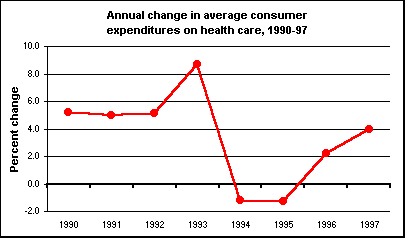An official website of the United States government
 United States Department of Labor
United States Department of Labor
Consumer units spent $34,819 on average in 1997, an increase of 3 percent over the previous year. Spending on health care averaged $1,841, an increase of 4 percent. Health care expenditures had risen 2 percent in 1996, after decreasing the previous two years.

[Chart data—TXT]
Health insurance, the largest component of health care expenditures, rose 6.6 percent in 1997, following a decrease of 4 percent in 1996. Expenditures on prescription and nonprescription drugs rose by 6 percent, while spending on medical supplies rose 11 percent. Consumer units increased their expenditures on medical services 2 percent.
In 1997, younger consumer units (reference persons under 25 years of age) spent 10 percent more on health care than a year earlier, largely due to increased spending on health insurance. In contrast, older consumer units (reference person age 75 and over) spent about 4 percent less on health care. However, older consumers still spent a much larger portion of their total income on health care than younger consumers (14 to 2 percent).
These data are a product of the BLS Consumer Expenditure Survey. Additional information is available from "Consumer Expenditures in 1997", Report 927. Expenditures data on health care track consumers' out-of-pocket expenses.
Bureau of Labor Statistics, U.S. Department of Labor, The Economics Daily, Medical care spending climbs again in 1997 at https://www.bls.gov/opub/ted/1999/mar/wk3/art02.htm (visited May 23, 2024).

